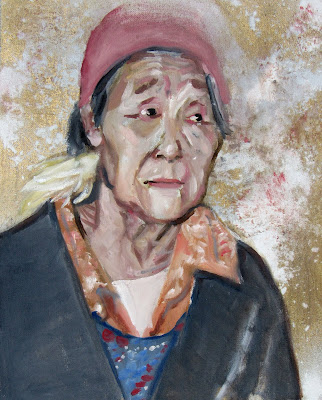 |
Ye'kuana (Makiritare) Indian, Venezuela
14 x 11 inches, oil on canvas, 2019 |
 |
Mataco (Michí) Indian, Argentina
14 x 11 inches, oil on canvas, 2019 |
The last several top 100 years have been framed by existential questioning. Why do I like what I like? Is one music better than another? Questions like these are why the Top 100 exists, they're integral to a system of ranking and filing. Last year's Top 100 was positioned around one central issue: The origins of music. Where does it come from? What, if any, is its function? The search for the origin really started when, in the 1980s, I discovered 1930s original blues songs that were popularly covered by some of my favorite bands then like Cream and Led Zeppelin. This was the onset of the Top 100 project. (I talk more about this during an interview on WGCU,
Three Song Stories.)
The quest for the origins of music, subject of a series of musings on this site, has lead me to listen to, and read about, recordings from the field of ethnomusicology. I have been seeking out recordings and information on the music of those cultures that have lived in relative isolation from the influence of civilizations, the industrial world. More half of the 100 songs in the 2018/2019 list belong to this category. Naturally I have become sympathetic to the plight and rights of such cultures. I first started to have an interest (in the political issue) in the late 1990s. This was a relatively positive time in which many governments allotted land and rights to the indigenous people living within their borders. Currently, however, the political trend is to revert back to colonial times.
The two paintings shown here are sort of a pair even though the origin of the two individuals are thousands of miles apart. The first one a Ye'kuana woman from Venezuela, below a Mataco Indian from Northern Argentina. Both images are based on anthropological images from the late nineteenth century. The Ye'kuana woman illustrates Yucca Fertility Song recorded by Walter Coppens and found on the album Anthology of Central & South American Indian Music (Folkways, 1975.) The song is a chant by women to stop evil spirits from affecting the yucca plant (the tree of life) recited during planting and harvesting. [W. Coppens] The Mataco Indian represents a mataco instrumental piece on a stringed instrument and is played by a shaman. (Argentina, The Indians of the Gran Chaco, Lyrichord, 1977.)
Many indigenous peoples, some still uncontacted, live in South American continent. The struggle of the South American Indians, as in the North, is well documented throughout this century and the last. The Selk'nam people, wiped out in a genocide courtesy of economic progress (gold was found on their territory,) I wrote about last year, is just one example of the devastating history of the fate of indigenous peoples after contact. While many protective laws are in place, the onslaught on territories held by indigenous peoples continues and is getting worse. Jair Bolsonaro, the latest Brazilian president, is emblemtic of these developments. He believes that indigenous people should be integrated and that way too much land is appropriated to them. He's firing scientists opposing his "manifest destiny" as Trump does to those defending Alaskan tribal societies. And the ecology again is victim.













